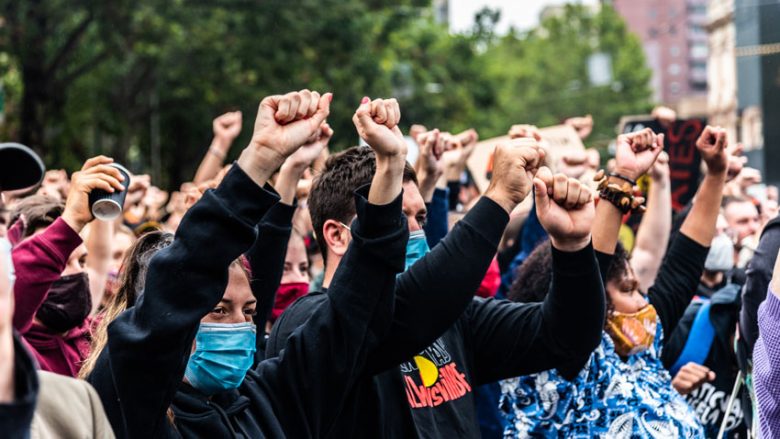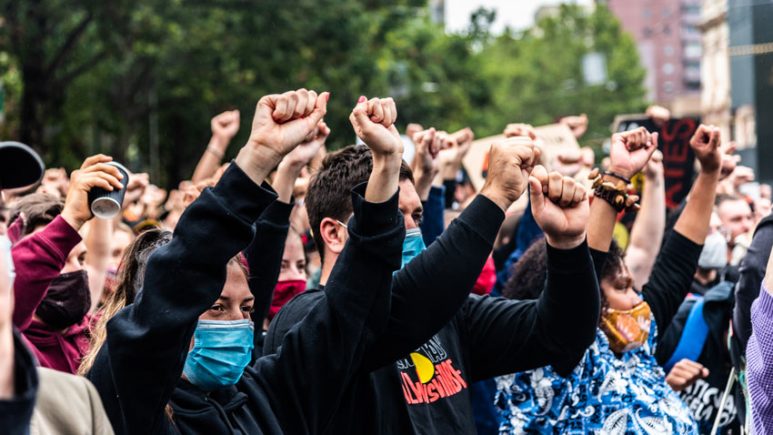By Luc Steinberg
January 26 has been celebrated nationally as Australia Day only since 1994, yet Indigenous Australians have been protesting the 26th as a day of mourning since 1938. Widely considered the date that the First Fleet made landfall in Sydney Cove, January 26 is viewed by many as a day to celebrate everything that has been achieved since those first 1000 or so convicts arrived, or just as a day off to watch cricket.
Not everyone has been willing to reckon with the brutality, massacres, denial of rights and dispossession that the world’s oldest surviving culture suffered through in the ensuing years of British colonial rule. Nor is everyone inclined to contend with the present where the past’s injustices manifest as an increasing gap between Indigenous and non-Indigenous rates of incarceration, continued deaths in custody and a shockingly wide disparity in life expectancy. However, in recent years, increasing calls to #changethedate, or find a different way to mark the date, have gained visibility and support.

Many lament the rise of social media as a disaster for social cohesion; for preferencing disinformation, draining the coffers of the fourth estate or facilitating hate speech and toxic interactions. But along with changes to education, recent films and music exploring Indigenous history and issues, and of course years of grassroots actions taken by Indigenous Australians, it seems as if social media – perhaps aided by celebrities with large followings like Chris Hemsworth (below) – has helped circulate and promote awareness of the need for truth-telling, reconciliation and reflection on Australia’s history. The hashtag #changethedate for example has grown significantly in popularity with an increase in usage of over 2000 per cent between 2016 and 2018 according to Twitter. Oddly, a quick glance at this year’s #AustraliaDay hashtag seemed to return significantly more results from non-Australians wishing their Australian friends a good day.
Caption: Thor star Chris Hemsworth urges Australia to #changethedate
Some of that fervour has spilt over to more mainstream or legacy media, where for instance, Australia’s national public broadcaster, the ABC’s youth radio station Triple J, decided to end broadcasting on January 26 of the Hottest 100 – a national countdown of the year’s most popular songs and voted for by millions – in 2017, citing a “growing dialogue around Indigenous recognition and perspectives on 26 January”.
That some of this social media virality seeps through to the more progressively inclined legacy outlets like Australia’s national public broadcasters, the ABC and SBS or publications like Crikey and The Guardian, is perhaps less surprising. However, as noted by Aboriginal writer Celeste Liddle, even coverage by the mainstream, commercial media has improved on previous years.
Australia’s most popular free to air TV channel, 9, for example, have shifted the tone and framing of their coverage of Australia Day protests to be more positive. An important step, as commercial stations have for years underreported protest numbers, needlessly emphasising police presence and embellishing or straight up inventing the potential for things to get out of hand. In another clip from Channel 7’s Today Show from 2019, the presenters defer to their Indigenous colleague, Brooke Boney, to ask her what her feelings are concerning the date: “I can’t separate the 26th of January with the fact that my brothers are more likely to go to jail than they are to go to school.” Such steps are incredibly important as negative media reporting on Indigenous issues has an effect on how Aboriginals and Torres Strait Islander peoples view themselves and their communities.
There is still more to be done.
Australia is perhaps one of the most multicultural nations on Earth. Yet, while around 58% of Australians have an Anglo-Celtic background, according to a study by Media Diversity Australia, “100% of free-to-air television national news directors have an Anglo-Celtic background (and they are all male)”. Such a lack of diversity is reflected in the way stories get told and who gets to tell them. A strong commitment to diversity in Australian news and current affairs is needed so that minority groups feel included and feel fairly and accurately represented. Although some targets for diversity have been met at the ABC, there is still more to be done. For instance, rally organisers consistently emphasise the need to address incarceration rates and closing the gap in life expectancy. On the other hand, media coverage of January 26 protests chooses to narrow its focus only on the date change as the purpose for the protests. Many in the community argue for keeping the date but to “find a way to unite around its meaning and reconcile”, in the words of Aboriginal lawyer and activist Noel Pearson for example. Unfortunately, the current nature of mainstream reporting leaves little room for nuance, preferring instead to represent the Indigenous community as entirely uniform in their opinions and motivations.
A 2017 poll showed just 15% of Australians want to change the date, while 54% of Indigenous Australians polled were in favour of a change. Most recent polls show that around 30% of all Australians support a change of date, which means the debate may rage on for some time but overwhelmingly young people are more likely to support the change. However, with thousands of journalism jobs being lost in recent years and hundreds of newspaper closures, especially in rural areas, it will be difficult to secure gains in Australia’s media diversity in the near future. Moreover, Rupert Murdoch owns a 70% stake in Australia’s print media with his company Newscorp – mouthpieces for conservative, right wing bias in the country. All this leaves less room for having the kinds of conversations and representation needed to bring about a change. In a clip from 2019 on ABC radio discussing media diversity in Australia, the CEO of the Creative Diversity Network UK, Deborah Williams, was asked by Professor Larissa Behrendt “how much catching up has Australia got to do?” she replied that “Australia is about 20 years behind the UK.” Without a stronger commitment to media pluralism and diversity it may be some time before that gap is closed as well.
Photo credit: Adam Calaitzis / Shutterstock

